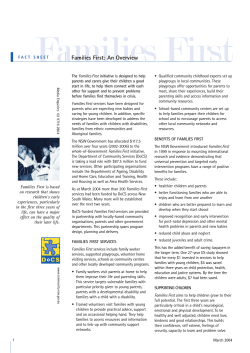
WHAT CAN YOU DO?
Ostoexetum zzriure WHAT CAN YOU DO? Vulput dolore conum il iniscid uipsust ionsequismod dolorpero exet sustrud molore conse te faci erci essecte tatie min vendrem delis nim nibht. Eriurercipis numsandre dolore facin henis am dolobor tincil dolorper suscidunt iure veniamc onulla con estinhenit. Odolorpero od magniam dolor ‘[4.1 pullout irit alis adit venit dolobortio quote rev] do odiam volut irilla consenim Elistr aliquat dolutpat am irilla faciduisi erosta. euguerostrud minibh esecte. Osto ex etum zzriure dit aci Im vullan eum dolore tate et qui tatin ugiate]’. Helping your child becomeutat a writer by: velit sisim aliquatue velis nostie eriliquis nullan amse • Reading toeuguerit them 3 to 5 books every day. tatum dipiscipit prat. For further information Dr Noella Mackenzie Lecturer in Literacy Studies, School of Education Charles Sturt University, Albury Wodonga Campus T 02 6051 9405 E nmackenzie@csu.edu.au Amanda Baldock NSW Department of Education and Communities Riverina Region T 02 6051 4327 E amanda.baldock@det.nsw.edu.au Paul Gleeson NSW Department of Education and Communities Riverina Region T 02 6937 3874 E paul.gleeson@det.nsw.edu.au © September 2012 NSW Department of Education and Communities • Taking them places that will feed their imagination eg. the park, the playground, Stetum zzriurit the farm, the zoo, the snow, the beach, the local library or the Henty Field Days. Eriurercipis numsandre Talk to them about the experience. b ecoming a w riter dolore facin henis am dolobor • Encouraging them to draw and talking to them tincil dolorper suscidunt iure aboutonulla their con drawings. veniamc estin henisl utpat dionsectet, quat enim • Showing them how you write (with a pen, on nosto doloreet num zriusc. the computer, on the phone). • Teaching them how to write their name and HELP YOUR CHILD Odolorpero magniam if they are interested, write other people’s names. Odolorpero od magniam dolor Encouraging them to write and giving them irit•alis adit venit dolobortio reasons eg.irilla cards, invitations or recipes. do odiam volut consenim dolutpat am irilla faciduisi • Drawing with them. euguerostrud minibh esecte. Osto ex etum zzriure dit aci Want totate know eum dolore et. more? http://www.csu.edu.au/faculty/educat/edu/staff/ profiles/lecturers/noella-mackenzie Developed in partnership with Springdale Heights Public School staff, students and parents. A joint initiative with DRAW TALK WRITE DRAW TALK WRITE Drawing is fun and helps your child to explore their world. Drawing is an important form of play. Drawing helps children learn to write. Talking helps children to learn about words they will need to read and write. Writing is another way for children to communicate and express themselves. Encourage children to continue to draw while they are learning to write. You can support your child by: You can support your child by: You can support your child by: •Encouraging them to draw and talk to you about their drawings. •Encouraging them to talk about the things that interest them in the books you read to them. •Asking them if they would like you to write on their drawings. •Providing them with tools for drawing. e.g. paper, pencils, textas, chalk. •Drawing with them and adding labels to some of their drawings. •Loading free drawing apps onto your ‘hand held’ computer for them to use. •Encouraging them to tell you about their day e.g. Who did you play with in the sand pit at preschool today? What stories did the teacher read to you? Did you learn any new songs? •Encouraging them to talk as they draw. •Teaching them how to write their name and show them how you write your name. •Helping them make shopping lists, cards, invitations – the opportunities are endless. •Letting your child see you write and talking to them about the different purposes for writing.
© Copyright 2025





















